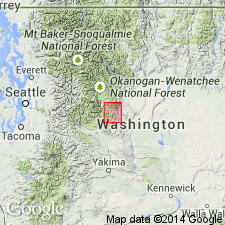
- Usage in publication:
-
- Chumstick Formation*
- Modifications:
-
- Named
- Geochronologic dating
- AAPG geologic province:
-
- Northern Cascade Range-Okanagan province
Summary:
Chumstick Formation is applied to rocks informally named Camas sandstone, an upper sedimentary unit of the Swauk Formation, by Russell (1900), following the informal usage of Buza (1976). Occurs in the Chiwaukum graben in the central Cascade Range of WA. Consists of whitish to buff-gray cross-bedded to massive feldspathic and pebbly sandstone of fluvial origin interbedded with conglomerate, shale, and minor amounts of tuff. Fanglomerates occur at the base and along the margins. Includes the fine-grained lacustrine Nahahum Canyon Member (new) in the upper part. Lies in the Chiwaukum graben and is bounded by the Leavenworth and Entiat faults, both active during the deposition of the Chumstick. Unconformably overlies weathered crystalline basement Swakane Biotite Gneiss; unconformably underlies the Wenatchee Formation (new). Thickness at the type section is 5800 m but is extremely variable elsewhere. Age is middle Eocene (45 Ma) based on radiometric (fission-track; zircon in tuff) analyses.
Source: US geologic names lexicon (USGS Bull. 1565, p. 63-64); GNU records (USGS DDS-6; Menlo GNULEX).
For more information, please contact Nancy Stamm, Geologic Names Committee Secretary.
Asterisk (*) indicates published by U.S. Geological Survey authors.
"No current usage" (†) implies that a name has been abandoned or has fallen into disuse. Former usage and, if known, replacement name given in parentheses ( ).
Slash (/) indicates name conflicts with nomenclatural guidelines (CSN, 1933; ACSN, 1961, 1970; NACSN, 1983, 2005, 2021). May be explained within brackets ([ ]).

